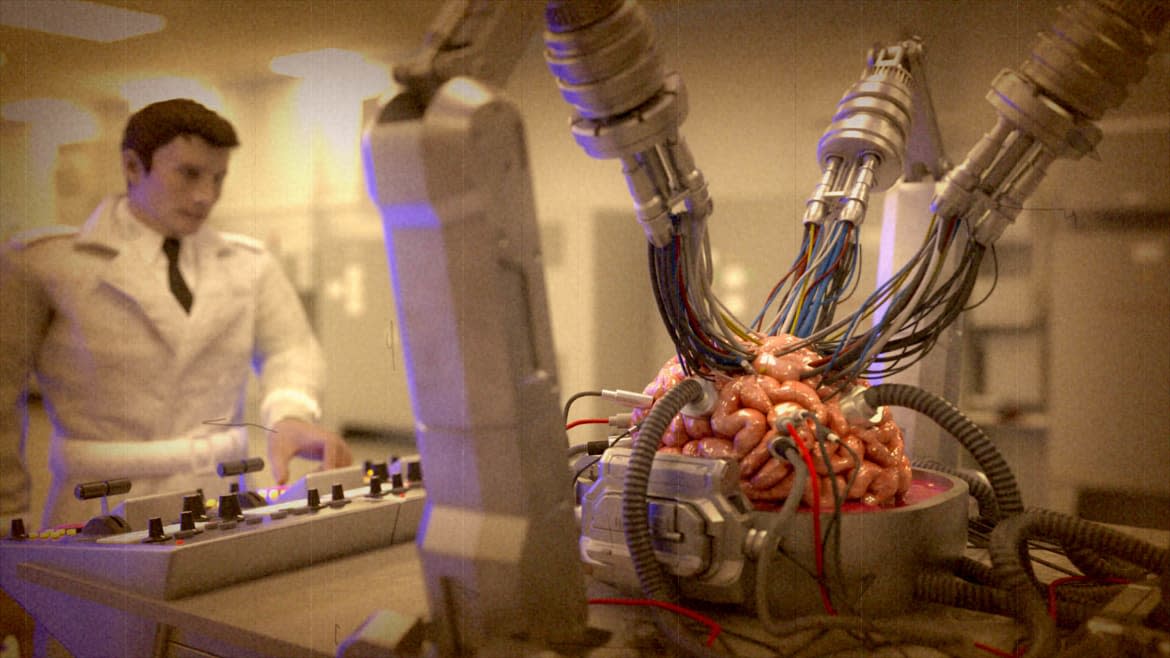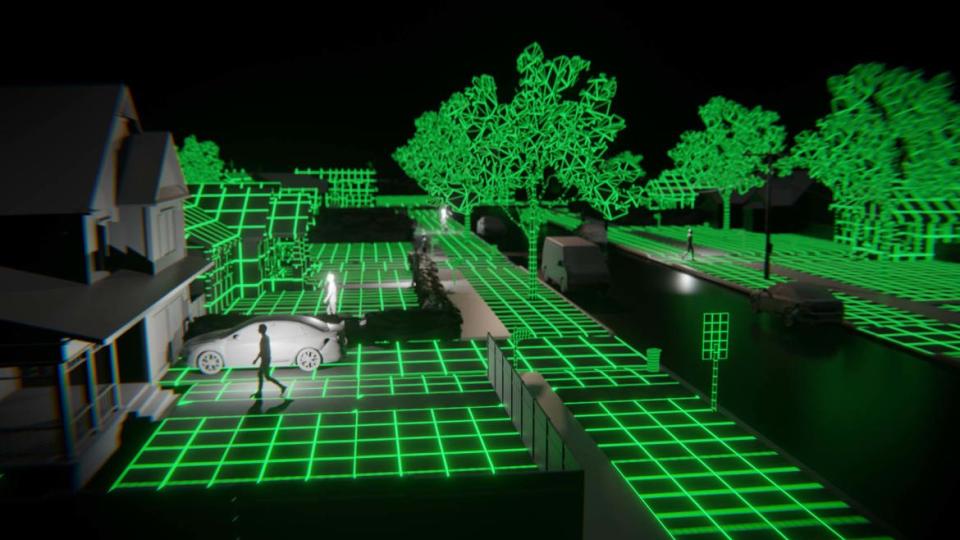He Thought He Was Living in ‘The Matrix’—and Killed His Parents

- Oops!Something went wrong.Please try again later.
Simulation theory posits that reality might not actually be real, but instead might be an illusion about which we are unaware, and from which we can possibly awaken, and it’s an idea that’s been investigated by everyone from Plato (with “The Cave”) and Descartes (with Meditations on First Philosophy) to, more recently, Philip K. Dick and The Matrix. It’s a fantasy of both escape and enslavement, liberation and manipulation, and one that taps into our own experiences moving between conscious and unconscious states, as well as losing ourselves in the fictional world of cinema. As such, it’s just about the ideal topic for documentarian Rodney Ascher, who on the heels of Room 237 (about The Shining as multifaceted puzzle-box) and The Nightmare (about sleep paralysis) once more ventures into unreal terrain with A Glitch in the Matrix, a compellingly out-there look at the possibility that we’re all avatars in a game we can’t comprehend.
Dick’s 1977 speech in Metz, France, titled, “If You Find This World Bad, You Should See Some of the Others,” forms the backbone of A Glitch in the Matrix (premiering in the Midnight Section of the Sundance Film Festival on Jan. 31, followed by a VOD debut on Feb. 5). In it, the famed author of A Scanner Darkly, The Man in the High Castle, Minority Report, Do Androids Dream of Electric Sheep? (the basis for Blade Runner), and We Can Remember It For You Wholesale (the basis for Total Recall) confesses that a 1974 dose of Sodium Pentothal for impacted wisdom teeth allowed him to have an “acute flash” of a “recovered memory” about a world, and life, that was not his own. Dick wrote extensively about this experience (known as “2-3-74”) in the posthumously released The Exegesis of Philip K. Dick, and it also informed his fictional output, much of which grappled with the unreliable and volatile nature of reality while imagining future societies in prophetic and poignant fashion.
Hugo Weaving: Why the Alt-Right’s Got ‘The Matrix’ All Wrong
Dick was the modern godfather of simulation theory, and A Glitch in the Matrix spends considerable time with people who’ve taken his seminal writing—as well as Lana and Lilly Wachowski’s The Matrix, itself intensely indebted to Dick—to heart. In Skype interviews with Ascher, these individuals appear disguised as outlandish digital avatars, including a red-faced armored lion, a Mechagodzilla-ish dragon in a tuxedo, a vaping alien in a puffy space suit, and a helmeted warrior with digital eyes and mouth. Their appearances speak to their own belief in dueling realities (and identities), which is also born from Elon Musk’s publicly stated conviction that we might be living in an artificial simulation run by advanced beings, as well as a 2003 academic paper by Oxford University professor Nick Bostrom (“Are You Living in a Computer Simulation?”) that advanced the hypothesis that we could be pawns in a hyper-advanced program that’s either recreating a past that’s already taken place (called an “ancestor simulation”), or a wholly new alternate timeline.
The notions forwarded by these speakers hinge on everything from anecdotal stories about their own breaks with reality, to arguments about coincidence, probability, and synchronicities, to outrageous—and highly specific—speculation about the details of our simulation. Suffice it to say, not all of it is convincing. It is, however, entertainingly insightful about mankind’s continual desire to explain grand mysteries through spiritual-by-way-of-scientific concepts about foreign realms, puppetmaster-ish higher powers, and technological exploitation.
To his credit, one interviewee (Paul Gude AKA the “lion”) concedes that maybe simulation theory is merely the easiest means by which his brain chooses to cope with the complexity of human existence. And in an earlier scene, he admits that his VR-based theory may be the byproduct of the fact that people always try to explain reality through the most advanced technology available at the moment. Boasting movie clips from, among others, The Wizard of Oz, The Truman Show, A Nightmare on Elm Street, Vertigo, The Thirteenth Floor, The Adjustment Bureau, They Live, Defending Your Life and, of course, The Matrix, A Glitch in the Matrix suggests that the movies are a prime vehicle for both creating and channeling these ideas, which are often rooted in feelings of loneliness, alienation and despair, and thus can result in particularly scary consequences.
That’s most harrowingly conveyed by an extended sequence in which Joshua Cooke explains (via audio interview, complemented by CGI recreations) how his infatuation with The Matrix, coupled with his abusive domestic life and undiagnosed mental illness, drove him to murder his adoptive parents in an attempt to discern whether he was, in fact, living inside the Matrix (his conclusion: “It messed me up really bad, because it wasn’t anything like I had seen on The Matrix. How real life was so much more horrific. It kinda jarred me”).
Cooke was 19 when he killed his adoptive parents with a 12-gauge shotgun in Virginia, and subsequently pleaded guilty and was sentenced to 40 years in jail. It became known as “The Matrix Case,” and as Cooke’s story makes clear, the danger of simulation theory is that, if nothing and no one is authentic, than ethical concerns about society, and your fellow man, are hopelessly undermined, leading to potential chaos. Unsurprisingly, the links between video games and simulation theory are numerous—Jesse Orion (i.e. the alien astronaut) says he spent years doing little more than playing games—and A Glitch in the Matrix taps into that connection by employing all sorts of computer-animated graphics (including from Google Earth and Minecraft) to visualize the suppositions of its subjects. Illuminating and amusing, the film’s playful digital form reflects and reveals truths about its content.

A scene from A Glitch in the Matrix
Set to Jonathan Snipes’ menacing electronic score, and also addressing the way in which déjà vu and the “Mandela Effect” relate to its central topic, A Glitch in the Matrix continues Ascher’s non-fiction study of communal tall tales, scientific hypotheses, and art analysis. Offering up a chorus of voices that seek to decipher the riddles of the universe and the atom through fanciful outlooks on the mind, body, and reality itself, his film is an eye-opening and shrewdly critical inquiry into our evolving perceptions of who we are, our deeply personal connection to big-screen dreams, and our persistent quest for knowledge about the things we don’t (yet) understand. It’s a treatise on religious and scientific yearning, and on human impulses and aspirations, that doubles as a portrait of crackpot conspiracy theories and mass delusion.
Get our top stories in your inbox every day. Sign up now!
Daily Beast Membership: Beast Inside goes deeper on the stories that matter to you. Learn more.

